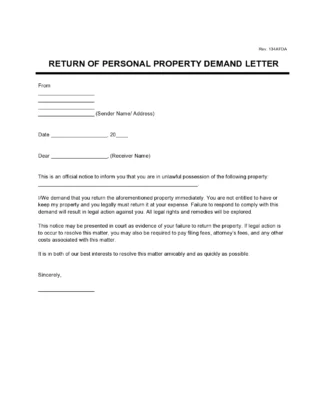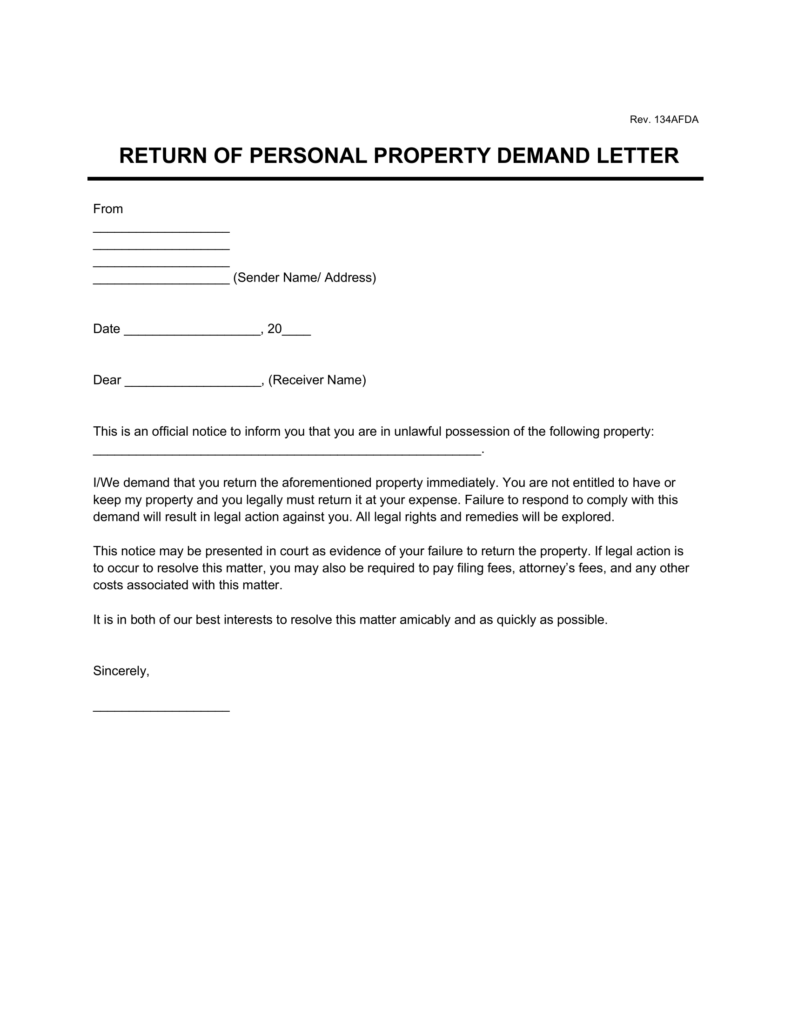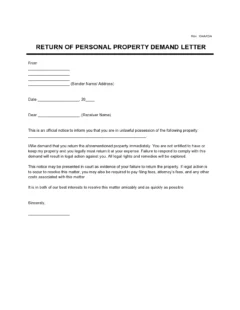
Use our free demand letter template to reclaim your personal property.

Published February 2, 2023
Written by Ioana Gagiuc | Reviewed by Brooke Davis
A personal property demand letter is a document that asks an individual or entity to return a piece of personal property to its rightful owner. These letters are official, which means you can use them to mention you are considering legal action.
Use our template below to start creating personal property demand letters. Feel free to edit and change the template’s language according to your needs.
A personal property demand letter or return of personal property demand letter is a document requesting the return of items owned by an individual or entity. At a minimum, it should:
A personal property demand letter is official, so you should keep the tone business-like, even if you are on familiar terms with the recipient. This also means you should stick to only the facts.

If your personal items are in someone else’s hands, you can get your belongings back by following these steps:
First, you must prove you own the property to get it back successfully. You can attach bank statements, public records, and return receipts to your letter.
Next, if the property can be contested, you must research ownership laws in your state.
For instance, most states consider engagement rings to be conditional gifts. Western states, like California , follow the conditional gift approach and award the ring to the giver if an engagement falls through. However, some states, like Montana , categorize the engagement ring as an unconditional gift and give a ring to the receiver when an engagement ends.
Once you’ve researched, it’s time to start writing the personal property demand letter. Start by describing how your property came to have the other entity or person. Be as descriptive and specific as possible—the demand letter may be used later in court.
Include as many sources as possible to prove that the property is yours. Consider using eyewitness accounts from family and friends as testimonies to support your claim.
Once you’ve finished the letter, send it through certified mail with a return receipt. Keep a copy of the return receipt requested for future reference. The receipt will show the person currently in possession of your property that they have been served with an official letter that can be used in court.
If the personal property demand letter recipient refuses to return your property, you should take legal action against them.
If your item is valued at $10,000 or less, consider going through the local Small Claims Court. Note, however, that every state has its own maximum allowable amount for small claims courts. Alaska, for instance, has a maximum amount of $10,000 , while Connecticut only has a limit of $5,000 .
Otherwise, you should hire an attorney and go to court.
You should write and serve a personal property demand letter if your property is in someone else’s hands. Here are the top scenarios when that could happen:
If you want to use a personal property demand letter to get your property back, follow these steps to write a personal property demand letter:
One of the best ways to write a personal property demand letter is to start with a sample letter. But it can be even easier if you create one in our document builder, as you only have to answer a few simple questions.
Add the name and date to the form. If you are writing this letter on behalf of your company, write the company’s name. Then, write the address.
Here’s an example of what this would look like:
John Smith
John Smith Game Design, Inc.
123 Second Street
Albany, NY
Add the letter’s calendar date across the two empty lines after the “Date” label. Then, add the recipient’s name after “Dear.”
Next, introduce yourself and outline the purpose of your letter. Name the item you want the recipient to return and how it came to be in their possession.
Ensure to identify your property fully. If it’s a car, state the license plate number and Vehicle Identification Number along with a detailed and accurate description. Be sure to include other items in the recipient’s possession, including fuel injectors.
For instance, you could write:
This letter concerns the red and black GeForce gaming laptop you borrowed on February 28, 2022, when we threw a party at your office. Since the aforementioned date, I have asked you to return my laptop five times: twice through text, two times in person, and once on the phone. I recently discussed this problem during a recent phone conversation on May 28, 2022. Unfortunately, all of these attempts have failed. This is my official request to obtain my property.
You should also mention the damages you’ve suffered from losing your property and include enclosed estimates of your losses.
To continue from the example above, you could say that losing your laptop has made it impossible to access certain 3D models. As a result, you could not complete certain client projects, leading to $5,000 in lost revenue and six negative reviews on Google Business.
Reference commercially reasonable prices to determine realistic damages.
After describing the item, you should present proof that it belongs to you. Mention any attached files, such as photos, receipts, documents, and eyewitness accounts.
Finally, tell the recipient what will happen if they fail to return your property by a certain date. Be polite — don’t use threats or improper language. Here’s an example of what you could say:
To ensure you have enough time to respond to my request, I will give you three weeks to reply to this letter. If you do not respond by [date], I will begin legal action. You will be responsible for all legal fees involved.
You can then end the letter with a “Sincerely, [your name or the name of your company].”
Here are some tips for writing an effective personal property demand letter:
It’s normal to be angry when writing a personal property demand letter. However, you should never be abusive or call the other party names. Be calm and direct, and leave your personal feelings out of the letter. Even if you know the recipient well, call them “Mr./Ms./Mx. [last name]” or “the defendant.”
Although a property demand letter is official, you should not use legalese. Instead, write for the recipient of the letter. Legalese can confuse people and make them anxious.
Summarize the letter’s main point at the beginning of the letter in a sentence or two. This lets the reader immediately know what the letter is all about.
Don’t assume the recipient already knows why you’re writing the letter. Tell the story of what happened from the very beginning, and include details like numbers, dates, model numbers, and amounts of money.
Not only does this help the recipient understand the purpose of your letter, but it will also help a judge understand your case if it goes to court. Judges who understand your letter are more likely to award you money.
Your demands should be reasonable. Don’t request relief that is unrealistic or unnecessary. For example, if the recipient did not damage your laptop and has seemingly just forgotten to return the laptop to you, you should not demand punitive damages—courts only award punitive damages for intentional harm.
Lastly, ensure the recipient receives the letter. If you work with a lawyer, they will send the demand letter on your behalf. If you are sending it yourself before starting a lawsuit, you should send it through the post office to get post office receipts.
A personal property demand letter can help you get your property back. However, writing a personal property letter can be difficult, especially if you have multiple other projects. Use LegalTemplates’ document builder to get started.

Create your own in minutes!